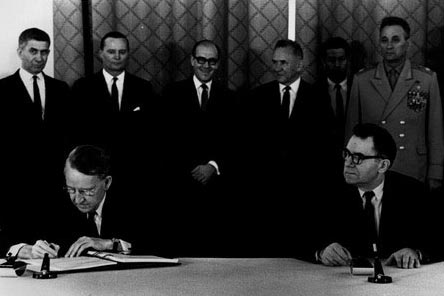1968 US Soviets Sign Non Proliferation Treaty
On July 1, 1968 the United States and the Soviet Union signed the nuclear non-proliferation treaty. The treaty committed both countries not to transfer nuclear weapons or nuclear technologies to other states. Other countries slowly signed the agreement and those non-nuclear countries who signed committed them not to receive nuclear technology. All parties agreed to cooperate in developing peaceful nuclear technologies..
The idea of an international treaty to prevent nuclear proliferation gained momentum in the late 1950s and early 1960s, with several countries expressing concern about the potential risks associated with the spread of nuclear weapons. In 1958, Ireland proposed a resolution at the United Nations General Assembly calling for the prevention of the spread of nuclear weapons. This resolution, known as the "Irish Resolution," was the starting point for discussions on the subject and led to further negotiations on a potential treaty.
The Eighteen Nation Committee on Disarmament (ENCD)
In 1961, the Eighteen Nation Committee on Disarmament (later expanded to the Conference of the Committee on Disarmament) was established, comprising representatives from various countries, including the United States and the Soviet Union. The ENCD became the primary forum for negotiations on the NPT.
The U.S. and the USSR both submitted draft treaties for consideration in 1965, but these drafts had significant differences. The United States sought to establish a comprehensive framework for non-proliferation, with strong verification measures and an emphasis on the peaceful use of nuclear energy. The Soviet Union's proposal, on the other hand, focused more on general principles and was less specific on verification and safeguards.
Bridging Differences and Reaching a Consensus
Over the next few years, negotiations within the ENCD centered on bridging the differences between the U.S. and Soviet proposals. The two superpowers engaged in a series of bilateral talks and consultations to address their respective concerns and find common ground. Both sides recognized the importance of preventing nuclear proliferation and acknowledged the need for a balanced approach that would take into account the interests of both nuclear-weapon states (NWS) and non-nuclear-weapon states (NNWS).
One significant breakthrough occurred in 1967 when the United States and the Soviet Union agreed on the basic principles of the treaty, which included the prevention of the spread of nuclear weapons, disarmament, and the promotion of peaceful uses of nuclear energy. They also agreed on the need for safeguards under the International Atomic Energy Agency (IAEA) to verify compliance by NNWS.
Another major issue in the negotiations was the inclusion of a provision on security guarantees for NNWS. The United States and the Soviet Union eventually agreed to address this issue in separate, unilateral statements rather than incorporating it into the treaty itself.
Finalizing the Treaty and Signature
With the key differences resolved, the final text of the Non-Proliferation Treaty was agreed upon in 1968. The NPT was opened for signature on July 1, 1968, and the United States and the Soviet Union were among the first to sign the treaty. The NPT entered into force on March 5, 1970, after the deposit of the required number of ratifications.
The NPT has three primary objectives: the prevention of nuclear proliferation, the promotion of nuclear disarmament, and the facilitation of peaceful nuclear cooperation. The treaty seeks to strike a balance between these objectives by preventing the spread of nuclear weapons and encouraging the reduction of existing stockpiles, while also allowing for the development and sharing of nuclear technology for peaceful purposes.
Key Provisions
The NPT is based on a central bargain, which involves commitments from both nuclear-weapon states (NWS) and non-nuclear-weapon states (NNWS):
-
Article I: Nuclear-weapon states pledge not to transfer nuclear weapons, other nuclear explosive devices, or related technology to any recipient, nor to assist, encourage, or induce any non-nuclear-weapon state to manufacture or acquire nuclear weapons.
-
Article II: Non-nuclear-weapon states commit not to receive, manufacture, or acquire nuclear weapons or other nuclear explosive devices, and not to seek or receive assistance in their manufacture.
-
Article III: Non-nuclear-weapon states agree to accept International Atomic Energy Agency (IAEA) safeguards on their peaceful nuclear activities to provide assurance that these activities are not diverted to weapons purposes.
-
Article IV: All parties have the inalienable right to develop, research, and use nuclear energy for peaceful purposes, and they agree to facilitate the fullest possible exchange of equipment, materials, and scientific and technological information for these purposes.
-
Article VI: All parties commit to pursuing negotiations in good faith on effective measures relating to nuclear disarmament and on a treaty on general and complete disarmament under strict and effective international control.
Significance and Continuing Relevance
The NPT has played a crucial role in limiting the number of nuclear-armed states and facilitating disarmament efforts. With 191 member states, the treaty is considered one of the most widely adhered-to international agreements. It has also established a global norm against the proliferation of nuclear weapons and provided a foundation for international non-proliferation efforts, such as export control regimes and UN Security Council resolutions.
 >
>